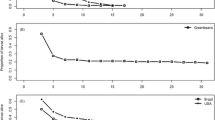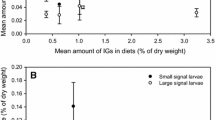Abstract
Secondary metabolites are one the most pervasive defensive mechanisms in plants. Many specialist herbivores have evolved adaptations to overcome these defensive compounds. Some herbivores can even take advantage of these compounds by sequestering them for protection and/or mate attraction. One of the most studied specialist insects that sequesters secondary metabolites is the arctiid moth Utetheisa ornatrix. This species sequesters pyrrolizidine alkaloids (PAs) from its host plant, the legume Crotalaria spp. The sequestered PAs are used as a predator repellent and as a mating pheromone. We used this species to test larval preference for different concentrations of PAs. We purified PAs from plant material and added them at different concentrations to an artificial diet. Larvae of U. ornatrix previously feeding on low and high PA concentration artificial diets were allowed to choose between two new artificial diets with different PA concentrations. The amount of PAs sequestered and larval preference were dependent on their previous exposure to low or high PA content in the diet. Larvae that were pretreated with a low PA diet significantly consumed more diet with the high PA concentration, while larvae that were pretreated with a high PA diet showed no discrimination between future feeding of different PA concentration diets. We discuss our results using mechanistic and evolutionary approaches. Finally, we discuss how these results have important implications on the evolution of plant herbivore interactions and how specialist herbivores may decrease the levels of chemical defenses on plant populations.


Similar content being viewed by others
References
Agrawal AA, Kurashige NS (2003) A role for isothiocyanates in plant resistance against the specialist herbivore Pieris rapae. J Chem Ecol 29:1403–1415
Bernays EA, Chapman RF, Lamunyon CW, Hartmann T (2003a) Taste receptors for pyrrolizidine alkaloids in a monophagous caterpillar. J Chem Ecol 29:1709–1722
Bernays EA, Rodrigues D, Chapman RF, Singer MS, Hartmann T (2003b) Loss of gustatory responses to pyrrolizidine alkaloids after their extensive ingestion in the polyphagous caterpillar Estigmene acrea. J Exp Biol 206:4487–4496
Bernays EA, Hartmann T, Chapman RF (2004) Gustatory responsiveness to pyrrolizidine alkaloids in Senecio specialist, Tyria jacobeae (Lepidoptera: Arctiidae). Physiol Entomol 29:67–72
Brown KS (1984) Adult-obtained pyrrolizidine alkaloids defend ithomiine butterflies against a spider predator. Nature 309:707–709
Cogni R (2010a) Coevolution at the population level: empirical studies in an insect-plant interaction, Ph.D. dissertation. Stony Brook University, Stony Brook, NY
Cogni R (2010b) Resistance to plant invasion? A native specialist herbivore shows preference for and higher fitness on an introduced host. Biotropica 42:188–193
Cogni R, Futuyma DJ (2009) Local adaptation in a plant herbivore interaction depends on the spatial scale. Biol J Linn Soc 97:494–502
Cogni R, Trigo JR, Futuyma DJ (2011) Varying herbivore population structure correlates with lack of local adaptation in a geographic variable plant-herbivore interaction. PLoS One 6:e29220
Cogni R, Trigo JR, Futuyma DJ (2012) A free lunch? No cost for acquiring defensive plant pyrrolizidine alkaloids in a specialist arctiid moth (Utetheisa ornatrix). Mol Ecol. doi:10.1111/mec.12086
Ehrlich PR, Raven PH (1964) Butterflies and plants: a study in coevolution. Evolution 18:586–608
Eisner T, Meinwald J (1995) The chemistry of sexual selection. Proc Natl Acad Sci USA 92:50–55
Ferro VG, Guimarães PR, Trigo JR (2006) Why do larvae of Utetheisa ornatrix penetrate and feed in pods of Crotalaria species? Larval performance vs. Chemical and physical constraints. Entomol Exp Appl 121:23–29
Flores AS, Tozzi AMGA, Trigo JR (2009) Pyrrolizidine alkaloid profiles in Crotalaria species from Brazil: chemotaxonomic significance. Biochem Syst Ecol 37:459–469
Guimarães PR, Raimundo RLG, Bottcher C, Silva RR, Trigo JR (2006) Extrafloral nectaries as a deterrent mechanism against seed predators in the chemically defended weed Crotalaria pallida (Leguminosae). Austral Ecol 31:776–782
Hartmann T (1999) Chemical ecology of pyrrolizidine alkaloids. Planta 207:483–495
Hartmann T, Ober D (2008) Defense by pyrrolizidine alkaloids: developed by plants and recruited by insects. In: Schaller A (ed) Induced plant resistance to herbivory. Springer, New York
Hartmann T, Theuring C, Beuerle T, Klewer N, Schulz S, Singer MS, Bernays EA (2005) Specific recognition, detoxification and metabolism of pyrrolizidine alkaloids by the polyphagous arctiid Estigmene acrea. Insect Biochem Mol Biol 35:391–411
Joshi J, Vrieling K (2005) The enemy release and EICA hypothesis revisited: incorporating the fundamental difference between specialist and generalist herbivores. Ecol Lett 8:704–714
Karban R, Agrawal AA (2002) Herbivore offense. Ann Rev Ecol Syst 33:641–664
Kelly CA, Norbutus AJ, Lagalante AF, Iyengar VK (2012) Male courtship pheromones as indicators of genetic quality in an arctiid moth (Utetheisa ornatrix). Behav Ecol 23:1009–1014
Lankau RA (2007) Specialist and generalist herbivores exert opposing selection on a chemical defense. New Phytol 175:176–184
Macel M (2011) Attract and deter: a dual role for pyrrolizidine alkaloids in plant-insect interactions. Phytochem Rev 10:75–82
Nishida R (2002) Sequestration of defensive substances from plants by Lepidoptera. Ann Rev Entomol 47:57–92
Pasteels JM, Termonia A, Windsor DM, Witte L, Theuring C, Hartmann T (2001) Pyrrolizidine alkaloids and pentacyclic triterpene saponins in the defensive secretions of Platyphora leaf beetles. Chemoecology 11:113–120
Rausher MD (2001) Co-evolution and plant resistance to natural enemies. Nature 411:857–864
Rosenthal GA, Berenbaum MR (1992) Herbivores: their interactions with secondary plant metabolites, 2nd edn. Academic Press, San Diego
Signoretti AGC, Nava DE, Bento JMS, Parra JRP (2008) Biology and thermal requirements of Utetheisa ornatrix (L.) (Lepidoptera: Arctiidae) reared on artificial diet. Braz Arch Biol Technol 51:647–653
Trigo JR (2000) The chemistry of antipredator defense by secondary compounds in neotropical Lepidoptera: facts, perspectives and caveats. J Braz Chem Soc 11:551–561
Trigo JR (2008) Chemical ecology of ithomiine butterflies. In: Epifano F (ed) Current trends in phytochemistry. Research Signpost, Kerala, pp 141–165
Trigo JR (2011) Effects of pyrrolizidine alkaloids through different trophic levels. Phytochem Rev 10:83–98
Trigo JR, Witte L, Brown KS, Hartmann T, Barata LES (1993) Pyrrolizidine alkaloids in the arctiid moth Hyalurga syma. J Chem Ecol 19:669–679
Trigo JR, Leal IR, Matzenbacher NI, Lewinsohn TM (2003) Chemotaxonomic value of pyrrolizidine alkaloids in southern Brazil Senecio (Senecioneae: Asteraceae). Biochem Syst Ecol 31:1011–1022
van Dam NM, Vuister LWM, Bergshoeff C, Vos H, van der Meijden E (1995) The “raison d’être” of pyrrolizidine alkaloids in Cynoglossum officinale: deterrent effects against generalist herbivores. J Chem Ecol 21:507–523
van der Meijden E (1996) Plant defense, an evolutionary dilemma: contrasting effects of (specialist and generalist) herbivores and natural enemies. Entomol Exp Appl 80:307–310
Acknowledgments
J. R. Parra and D. Navas provided the artificial diet protocol. The manuscript was improved by comments from D. Rodrigues and two anonymous reviewers. We thank D. J. Futuyma for discussions about this project. M. F. Pereira helped in the laboratory. We thank the Functional Ecology Research and Training Laboratory (SBU) for equipment use. We also thank the Instituto Brasileiro do Meio Ambiente e dos Recursos Naturais Renováveis and the U.S. Department of Agriculture for permits to export and import live organisms. This work is contribution number 1222 in Ecology and Evolution from the Stony Brook University. Financial support was provided by the National Science Foundation (DEB 0807418) to RC and the Fundação de Amparo à Pesquisa do Estado de São Paulo and the Conselho Nacional de Desenvolvimento Científico e Tecnológico (98/01065-7, 11/17708-0, and 304969/2006-0) to JRT.
Author information
Authors and Affiliations
Corresponding author
Additional information
Handling Editors: Yvan Rahbe and Heikki Hokkanen.
Rights and permissions
About this article
Cite this article
Hoina, A., Martins, C.H.Z., Trigo, J.R. et al. Preference for high concentrations of plant pyrrolizidine alkaloids in the specialist arctiid moth Utetheisa ornatrix depends on previous experience. Arthropod-Plant Interactions 7, 169–175 (2013). https://doi.org/10.1007/s11829-012-9232-1
Received:
Accepted:
Published:
Issue Date:
DOI: https://doi.org/10.1007/s11829-012-9232-1




